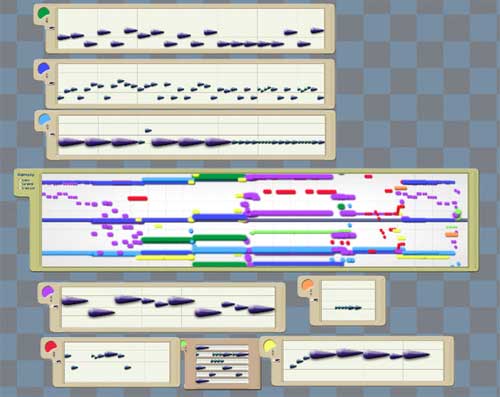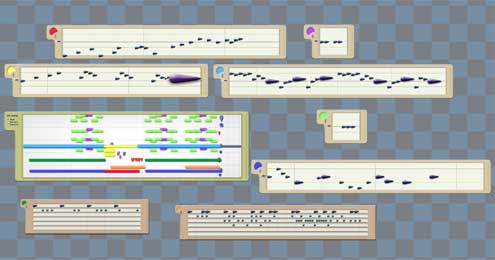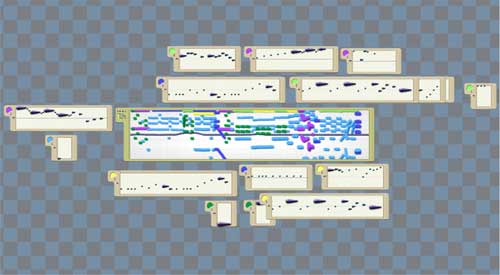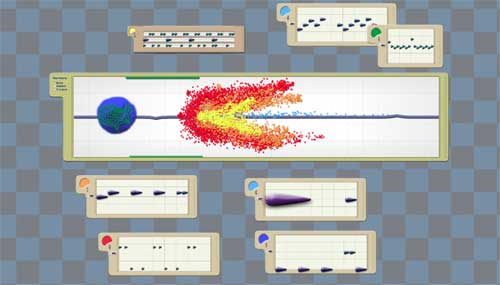Hyperscore (2000-2006)
Design and implementation by Mary Farbood and Egon Pasztor |
||||
|
Hyperscore is a graphical computer-assisted composition program
intended to make
composing music accessible to users without musical training as well as experienced musicians.
The software maps complex musical concepts to intuitive visual representations.
Color, shape, and texture are used to convey high-level musical features such as timbre,
melodic contour, and harmonic tension. 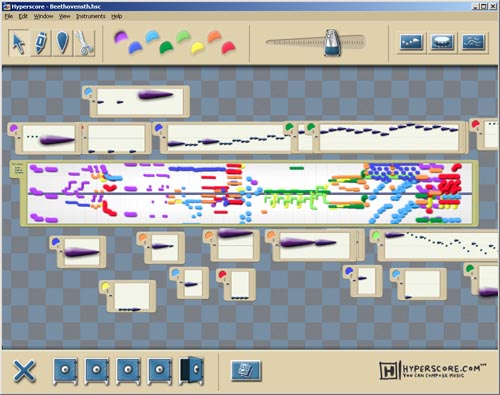 Screenshot showing a Hyperscore rendering of the exposition of the first movement of Beethoven's Fifth Symphony.
Users start by first creating simple melodies or sequences of notes.
A library of predefined elements is also provided. These melodies are assigned unique colors.
The user then creates a musical sketch composed of colored lines,
where the motivic material generated for each line corresponds to the sequence associated with the given color.
The contour and position of the line alters the pitch at which notes are played back.
Hyperscore also provides users with control over tempo, dynamics, and harmony. General MIDI is used for
audio output, but the addition of recording and sample-based audio is currently under development.
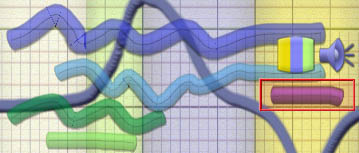 Hyperscore has garnered considerable acclaim for its novel and intuitive approach to computer-assisted composition. It has received international media attention and awards and has been featured in numerous news and journal publications, as well as television programs such as Scientific American Frontiers. It has also been exhibited at the Cooper-Hewitt National Design Museum in New York, Casa da Musica in Porto, Portugal, and other locations worldwide.
I'm in the process of adding new features and releasing new versions. Hyperscore is now
a commercial product and can be downloaded and purchased from Harmony Line.
Graphical depictions of functional harmony
The software can generate and apply different classes of automated harmonization.
Hyperscore has a harmonic tension "line" that can be shaped by the user and transformed into
chord progressions that are implied by the contour of the line. These progressions are
then applied to the music composed by the user, which is transformed to conform to the generated harmony.
The gestural elements in the harmony line imply different functional categories for the chords selected.
The texture of the line in a given a sections determines the kinds of chords chosen given the functional category.
 An empty Hyperscore sketch window showing the harmony line. The height or depth of the point indicates the key to which the section modulates (indicated by the text overlay). Recent Examples of Hyperscore Compositions (2005-2006)Since the earliest versions of the software have been released to the public, users have been creating interesting and diverse music with the software. While some of these composers are musicians, many others have little or no musical background but have been able to successfully compose music in Hyperscore. The examples below are pieces written by users on our community site H-Lounge.
|
||||
Some History
Early versions of the software (2001-2003) allowed users to generate novel compositions from
predefined motivic material by sketching lines indicating patterns of musical tension.
 Screenshots of three earlier versions of Hyperscore.
The application evolved to play a prominent role in the Toy Symphony. During an international
tour of this project, children were given the opportunity to compose orchestral
pieces using Hyperscore, which were then performed in concert along with other works
utilizing traditional and technologically enhanced instruments and approaches.
|
[Home]
6f772049 20646c75 656b696c 206f7420 656b6174 77206120 206b6c61 74206e6f 42206568 6b6f6f72 206e796c 64697242 77206567 20687469 20656874 20656e6f 6f6c2049 0a2e6576 75656845 67756620 73656361 62616c20 75746e75 6e612072 202e696e 6f540a20 20796d20 74756f79 61202c68 61206576 65757174 6c617620 000a2e65
Last modified: 2 January 2007
